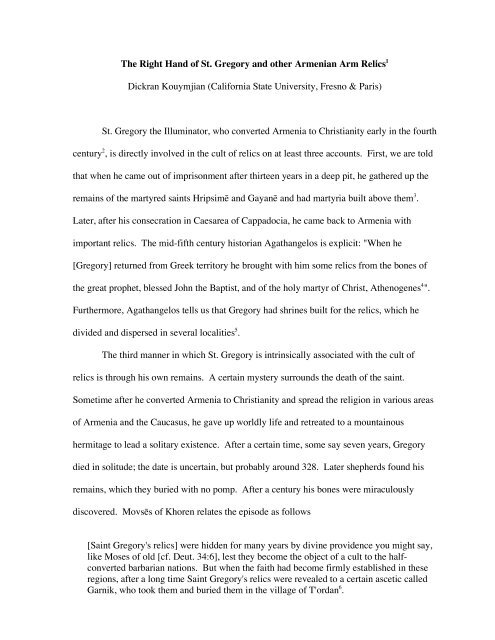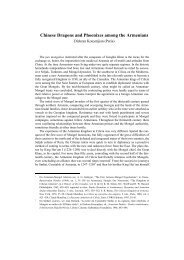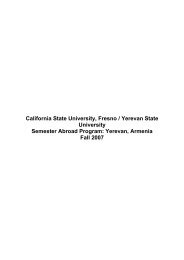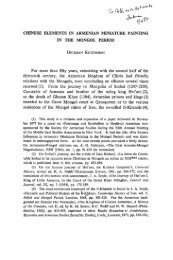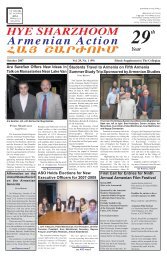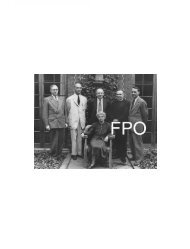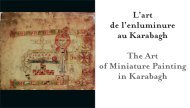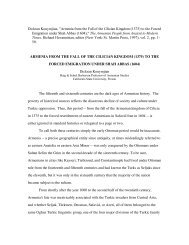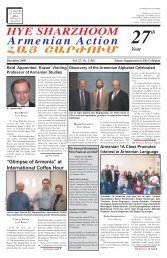The Right Hand of St. Gregory and other Armenian Arm Relics
The Right Hand of St. Gregory and other Armenian Arm Relics
The Right Hand of St. Gregory and other Armenian Arm Relics
Create successful ePaper yourself
Turn your PDF publications into a flip-book with our unique Google optimized e-Paper software.
<strong>The</strong> <strong>Right</strong> <strong>H<strong>and</strong></strong> <strong>of</strong> <strong>St</strong>. <strong>Gregory</strong> <strong>and</strong> <strong>other</strong> <strong><strong>Arm</strong>enian</strong> <strong>Arm</strong> <strong>Relics</strong> 1Dickran Kouymjian (California <strong>St</strong>ate University, Fresno & Paris)<strong>St</strong>. <strong>Gregory</strong> the Illuminator, who converted <strong>Arm</strong>enia to Christianity early in the fourthcentury 2 , is directly involved in the cult <strong>of</strong> relics on at least three accounts. First, we are toldthat when he came out <strong>of</strong> imprisonment after thirteen years in a deep pit, he gathered up theremains <strong>of</strong> the martyred saints Hripsimē <strong>and</strong> Gayanē <strong>and</strong> had martyria built above them 3 .Later, after his consecration in Caesarea <strong>of</strong> Cappadocia, he came back to <strong>Arm</strong>enia withimportant relics. <strong>The</strong> mid-fifth century historian Agathangelos is explicit: "When he[<strong>Gregory</strong>] returned from Greek territory he brought with him some relics from the bones <strong>of</strong>the great prophet, blessed John the Baptist, <strong>and</strong> <strong>of</strong> the holy martyr <strong>of</strong> Christ, Athenogenes 4 ".Furthermore, Agathangelos tells us that <strong>Gregory</strong> had shrines built for the relics, which hedivided <strong>and</strong> dispersed in several localities 5 .<strong>The</strong> third manner in which <strong>St</strong>. <strong>Gregory</strong> is intrinsically associated with the cult <strong>of</strong>relics is through his own remains. A certain mystery surrounds the death <strong>of</strong> the saint.Sometime after he converted <strong>Arm</strong>enia to Christianity <strong>and</strong> spread the religion in various areas<strong>of</strong> <strong>Arm</strong>enia <strong>and</strong> the Caucasus, he gave up worldly life <strong>and</strong> retreated to a mountainoushermitage to lead a solitary existence. After a certain time, some say seven years, <strong>Gregory</strong>died in solitude; the date is uncertain, but probably around 328. Later shepherds found hisremains, which they buried with no pomp. After a century his bones were miraculouslydiscovered. Movsēs <strong>of</strong> Khoren relates the episode as follows[Saint <strong>Gregory</strong>'s relics] were hidden for many years by divine providence you might say,like Moses <strong>of</strong> old [cf. Deut. 34:6], lest they become the object <strong>of</strong> a cult to the halfconvertedbarbarian nations. But when the faith had become firmly established in theseregions, after a long time Saint <strong>Gregory</strong>'s relics were revealed to a certain ascetic calledGarnik, who took them <strong>and</strong> buried them in the village <strong>of</strong> T'ordan 6 .
NOTIZIARIO SULL’ECONOMIA UNGHERESE8 settembre 2012 – 21 settembre2012SommarioANDAMENTO MACROECONOMICO ............................................................................................................................. 2Finanziaria e stabilità macroeconomica e fiscale...................................................................................................... 2Crescita: <strong>St</strong>atistica ungherese rivede al ribasso le stime del PIL ungherese ............................................................. 2Pubblico impiego – Ministro Funzione Pubblica ungherese smentisce tagli al pubblico impiego ............................. 3Lavoro – cala il tasso medio di disoccupazione del 10,5% ....................................................................................... 3Pronta la proposta di legge per la salvaguardia del lavoro e il rilancio dell’occupazione ........................................... 3Aziende di interesse strategico per l’Ungheria ......................................................................................................... 3SETTORE FINANZIARIO ................................................................................................................................................ 4Commissioni bancarie - Raiffeisen Bank dovrà restituire 290 milioni di fiorini alla clientela ..................................... 4MOL annuncia un programma di obbligazioni ......................................................................................................... 4INDUSTRIA .................................................................................................................................................................. 4Cartiere - Trasferimento di Forest Papír a Lábatlan .................................................................................................. 4TRASPORTI .................................................................................................................................................................. 4Autostrade – il Governo approva il sistema di pedaggio elettronico per gli autotrasporti ........................................ 4NOTIZIE ICE ................................................................................................................................................................. 5Sangjin investe 7 milioni di euro .............................................................................................................................. 5Haribo aumenta produzione nella fabbrica di Nemesvámos .................................................................................... 5Árkád diventerà il più gr<strong>and</strong>e centro commerciale in Ungheria................................................................................ 5Nuovi investimenti nell’ambito del Programma transfrontaliero Ungheria-Romania ............................................... 5Ampliamento presso la Kirchh<strong>of</strong>f Hungária di Esztergom ......................................................................................... 6Investimento a Balatonfűzfő ................................................................................................................................... 6Partita la costruzione dell’impianto di Biogas a Tatabánya ...................................................................................... 6Incubatore di imprese a Győr .................................................................................................................................. 6Inaugurato il nuovo centro di controllo del traffico aereo a Ferihegy ...................................................................... 6Nuovo incubatoio di pollame a Petneháza ............................................................................................................... 7DISCLAIMERLe informazioni contenute nel presente notiziario sono tratte da comunicati ufficiali, sitiistituzionali e organi di informazione ungheresi. L’Ambasciata non può verificare lacorrettezza né essere considerata responsabile del contenuto delle informazioni pubblicate.1
<strong>Gregory</strong> were taken to Naples 13 . However, the skull must have been taken to Romeafterward, because it was there whence it was brought to Naples in 1628 to be placed in thenew monastery <strong>of</strong> San Gregorio <strong>Arm</strong>eno 14 .<strong>The</strong>re is no absolute pro<strong>of</strong> that demonstrates when any <strong>of</strong> the bones <strong>of</strong> the saint becameseparated as an arm relic, some speculate the ninth century. But Babgen Gulesserian in hismassive history <strong>of</strong> the Cilician Catholicosate says,[W]e do not know by whom, where, or when the dexter <strong>of</strong> <strong>Gregory</strong> was separated fromhis relics. Among the treasures <strong>of</strong> the Cilician kingdom along with the holy relic <strong>of</strong> thecross, the dexter <strong>of</strong> <strong>Gregory</strong> is mentioned as one <strong>of</strong> the objects used in assemblies.Contrary to the precepts <strong>of</strong> the <strong><strong>Arm</strong>enian</strong> church it was believed among unworthyc<strong>and</strong>idates that who ever possessed the holy arm relic, he is the catholicos, <strong>and</strong> thus as aresult <strong>of</strong> unfounded underst<strong>and</strong>ing, the dexter disappeared, reappeared, or <strong>other</strong>s werecreated 15 .By 1113 a h<strong>and</strong> relic may have existed, even though there is no direct reference to such anobject in the sources. In that year, Davit' T'ornikian declared himself catholicos at Aght'amaron the basis <strong>of</strong> possessing the altar, veil, <strong>and</strong> staff <strong>of</strong> <strong>St</strong>. <strong>Gregory</strong>. Thus started the tradition(false as has been pointed out) that possession <strong>of</strong> <strong>Gregory</strong>'s relics is a justification forcatholicosal authority, because they were used as one <strong>of</strong> the justifications for theestablishment <strong>of</strong> the Catholicosate <strong>of</strong> Aght'amar at Lake Van 16 . <strong>The</strong> thirteenth centuryhistorian Vardan in discussing this episode, did not, however, mention the right h<strong>and</strong> relic,though Mikael Ch'amch'ian in the eighteenth century lists it among the relics probablythrough a careless reading <strong>of</strong> a manuscript 17 . On the <strong>other</strong> h<strong>and</strong>, according to a colophon <strong>of</strong>1173, the dexter <strong>of</strong> <strong>St</strong>. <strong>Gregory</strong> seems to have been at Aght'amar before it turned up late inthe twelfth century in Cilicia 18 .How the relic got to Cilicia or when is unclear, though some have conjectured it wasstolen <strong>and</strong> brought from Aght'amar, assuming it had been there, while Catholicos BabgenGulesserian believed it was an invention <strong>of</strong> the catholicosate after its establishment in Cilicia3
A long <strong>and</strong> rather circumstantial colophon <strong>of</strong> 1462 describes the journey <strong>of</strong> Zakariawith the holy relic from Etchmiadzin to Aght'amar. I quote sections from his arrival in thecity <strong>of</strong> Van <strong>and</strong> then onto the isl<strong>and</strong>.[Zakaria] entered the city <strong>of</strong> Van with numerous bishops, vardapets, <strong>and</strong> priests <strong>and</strong>multitudes <strong>of</strong> people with horses <strong>and</strong> horsemen. <strong>The</strong> priests, who walked both in front <strong>of</strong><strong>and</strong> behind the banner, sang sweet melodies. …But the baron who occupied the fortress<strong>of</strong> Semiramis, that is, the citadel <strong>of</strong> Van, … Mahmut Bek, …wished to see the holy righth<strong>and</strong>, <strong>and</strong> he sent for it. When the great pontiff, ... entered the gate <strong>of</strong> the uppermost part<strong>of</strong> the citadel, the tyrant Mahmut Bek came out to greet him with all his chieftains <strong>and</strong>their families <strong>and</strong> with his sons. <strong>The</strong>y fell down before the holy right h<strong>and</strong> <strong>and</strong> kissed it;<strong>and</strong> they <strong>of</strong>fered supplications.... <strong>The</strong> multitudes <strong>of</strong> the city <strong>and</strong> <strong>of</strong> the canton arrivedevery day with numerous gifts <strong>and</strong> <strong>of</strong>ferings, <strong>and</strong> prostrated themselves before the holyright h<strong>and</strong> <strong>and</strong> greeted the great pontiff. ... [L]ater [Zakaria] obtained ... permission toproceed to his ancestral seat at Aght'amar. … <strong>The</strong>y arrived near the coastal city <strong>of</strong>Vostan. All <strong>of</strong> its inhabitants, priests <strong>and</strong> multitudes <strong>of</strong> people <strong>of</strong> all ranks, came out togreet them with incense <strong>and</strong> c<strong>and</strong>les <strong>and</strong> resounding melodies…. <strong>The</strong> ecclesiasticalbanner was carried in front, <strong>and</strong> the golden cross affixed on the top shone like a light....When the alien inhabitants <strong>of</strong> Vostan witnessed this rejoicing, they were deeplyaggrieved by the splendor <strong>and</strong> by the forwardness <strong>of</strong> the pontiff.… [T]hey conceived anevil plan, to plot secretly against (him)…. When the brave overseer (Zakaria) learned <strong>of</strong>their wicked intent, he took the holy right h<strong>and</strong> <strong>and</strong> at dawn … boarding (a) boat, went tohis ancestral domain, the God-inhabited isl<strong>and</strong> <strong>of</strong> Aght'amar 29 .Interestingly the narrative mentions the shining <strong>of</strong> the golden crucifix but does not refer tothe physical appearance <strong>of</strong> the relic <strong>of</strong> <strong>St</strong>. <strong>Gregory</strong>, which presumably did not shine. Was itencased in a silver reliquary? If <strong>and</strong> how it got back to Etchmiadzin from Aght'amar isunclear, but by the seventeenth century Etchmiadzin has the one which causes Arak'el tomake his research.<strong>The</strong> <strong>other</strong> relic <strong>of</strong> the right h<strong>and</strong> <strong>of</strong> <strong>St</strong>. <strong>Gregory</strong>, kept at the Catholicosate <strong>of</strong> Cilicia atSis, survived both the destruction <strong>of</strong> the last <strong><strong>Arm</strong>enian</strong> kingdom in 1375 <strong>and</strong> the transfer orreestablishment <strong>of</strong> the catholicosate in Holy Etchmiadzin in 1441. In 1479, the Cilician armrelic <strong>of</strong> <strong>St</strong>. <strong>Gregory</strong> mysteriously was found at Kars Bazar about 30 kilometers from Sis <strong>and</strong>bought back from a Turk 30 . We next hear <strong>of</strong> the dexter in 1765 when a silver chest (fig. 1)was made to house it along with the three <strong>other</strong> h<strong>and</strong> relics belonging to the Cilician See 31 .5
<strong>The</strong>se remained in Sis until the <strong><strong>Arm</strong>enian</strong> genocide <strong>of</strong> 1915, when all the treasures <strong>of</strong> thecatholicosate were hurriedly transferred by ox cart from Sis to Aleppo while the Turks weremassacring the <strong><strong>Arm</strong>enian</strong> population <strong>of</strong> Cilicia 32 . <strong>The</strong> ultimate chapter in the relic'stormented history occurred in Antelias, Lebanon, the final post-Genocide home <strong>of</strong> theCilician See, at the time <strong>of</strong> the election <strong>of</strong> Zareh Payaslian as Catholicos <strong>of</strong> Cilicia in 1956.<strong>The</strong> election was bitterly contested <strong>and</strong> declared illegal by the Vazgen Catholicos <strong>of</strong>Etchmiadzin who made the voyage from Soviet <strong>Arm</strong>enia to Lebanon for the election 33 .During the momentous events the Cilician right arm relic disappeared <strong>and</strong> was only found ayear later in Jerusalem <strong>and</strong> brought back triumphally to Lebanon by Archbishop, laterCatholicos, Khoren Paronian 34 .<strong>The</strong> ecclesiastical authority associated with the right arm <strong>of</strong> <strong>St</strong>. <strong>Gregory</strong>, its power toconfer legitimacy on the bishop or bishops who control it, explains in great part themultiplicity <strong>of</strong> this relic. But this authority <strong>and</strong> sanctity is also associated, perhaps to a lesserdegree, with <strong>other</strong> <strong><strong>Arm</strong>enian</strong> h<strong>and</strong> relics. I have recorded some thirty such h<strong>and</strong> or armreliquaries. <strong>The</strong>y include three dexters <strong>of</strong> John the Baptist, the Apostle Thaddeus, theApostle Thomas, <strong>St</strong>. James <strong>of</strong> Nisibis, <strong>St</strong>. <strong>St</strong>ephen the protomartyr, two <strong>of</strong> <strong>St</strong>. Nicholas (fig.2), <strong>St</strong>. Barsauma the Syrian, <strong>St</strong>. Sylvester (fig. 3), Aristakes the son <strong>and</strong> successor <strong>of</strong> <strong>St</strong>.<strong>Gregory</strong>, <strong>St</strong>. Sahak, <strong>and</strong> <strong>other</strong>s.Undoubtedly, the most famous are those <strong>of</strong> <strong>St</strong>. <strong>Gregory</strong> kept by the two catholicosalsees. It is virtually impossible to know which <strong>of</strong> these is the oldest. Whether one is the truerelic is also a futile question for reasons to be discussed below.<strong>St</strong>. <strong>Gregory</strong>'s right h<strong>and</strong> kept at Holy Etchmiadzin (fig. 4) is encased in a gilded armshapedreliquary fashioned in 1657 35 ; it is the one used to this day to bless the holy chrism in<strong>Arm</strong>enia. <strong>The</strong> h<strong>and</strong> is shown making the sign <strong>of</strong> the cross (benediction or blessing) in the6
eastern or Greek/<strong><strong>Arm</strong>enian</strong> manner with three figures held out (the Latins only use tw<strong>of</strong>ingers). A jeweled gold ring is on the thumb <strong>and</strong> a lavish b<strong>and</strong> at the wrist. <strong>The</strong> forearm <strong>of</strong>the reliquary depicts, under delicately fashioned arches, scenes from <strong>St</strong>. <strong>Gregory</strong>'s tortureswhile prisoner <strong>of</strong> King Trdat. When the h<strong>and</strong> is held over someone or simply turned towardthe faithful, the sign <strong>of</strong> the cross <strong>of</strong> this most sacred relic <strong>of</strong> the <strong><strong>Arm</strong>enian</strong> Church functionsas a blessing directly from God as well as protection against evil, because it is believed that<strong>Gregory</strong> <strong>and</strong> all saints ascended to heaven <strong>and</strong> are with God. Several medieval western armrelics specifically mention the term Dextera Die, the h<strong>and</strong> <strong>of</strong> God 36 . A h<strong>and</strong> also serves asthe iconographical representation <strong>of</strong> the Lord in scenes such as the Sacrifice <strong>of</strong> Abraham, <strong>St</strong>.John dictating his Gospel to Prochorus, or in the famous tenth century icon-like woodenDescent from the Cross called the Amenaprkitch Sourp Nishan (the 'Savior <strong>of</strong> All' HolyCross) <strong>of</strong> Havuts' Tar (fig. 5).In contrast, the right h<strong>and</strong> reliquary <strong>of</strong> <strong>St</strong>. <strong>Gregory</strong> belonging to the Catholicosate <strong>of</strong>Cilicia, in Antelias (fig. 6), displays a different form: the h<strong>and</strong> is open, like the h<strong>and</strong> <strong>of</strong> thebishop when he baptizes or the h<strong>and</strong>s <strong>of</strong> bishops when they are laid on for the consecration <strong>of</strong>bishops or a catholicos. This is also a representation <strong>of</strong> blessing rendering the power <strong>of</strong> Godthrough the bishop or, in the case <strong>of</strong> the open h<strong>and</strong> relic, <strong>of</strong> the saint it represents. <strong>The</strong>present Cilician reliquary was fashioned in 1928 in Aleppo by the Kalemkarian br<strong>other</strong>s <strong>of</strong>Aintab at the comm<strong>and</strong> <strong>of</strong> Catholicos Sahak 37 . <strong>The</strong> h<strong>and</strong> itself is rendered in a realisticfashion with all its wrinkles rather than the idealized one <strong>of</strong> Etchmiadzin. One imagines themodel could have been the h<strong>and</strong> <strong>of</strong> the craftsman, or perhaps even <strong>of</strong> Catholicos Sahak. <strong>The</strong>engraving <strong>of</strong> the bust <strong>of</strong> <strong>St</strong>. <strong>Gregory</strong> (fig. 7) with all his ecclesiastical regalia is not veryelegant. Its orientation is also strange, since h<strong>and</strong> relics are held upright during the blessing<strong>of</strong> the oil or in processions, the saint would appear upside down. <strong>The</strong> forearm <strong>of</strong> the relic is7
in a different style from the h<strong>and</strong> <strong>and</strong> appears to be an older element reused. A church iscarved on it <strong>and</strong> the legend (partially effaced) reads Holy Etchmiadzin, though the structuredepicted is not a good likeness <strong>of</strong> the historic see. It is hard to tell what the original form <strong>of</strong>this reliquary was. <strong>The</strong> only representations <strong>of</strong> it prior to its restoration, but after its journeyfrom Sis to Aleppo are two older group photos showing it with the arm relics <strong>of</strong> <strong>St</strong>. Sylvester<strong>and</strong> <strong>St</strong>. Nicholas 38 . <strong>St</strong>. <strong>Gregory</strong>'s is wrapped in a crude fabric not affording a view <strong>of</strong> the armcasing or h<strong>and</strong> <strong>of</strong> the reliquary itself (fig. 8). <strong>The</strong> protruding fingers, however, make clearthat the h<strong>and</strong> was open, but somewhat different than its appearance today. <strong>The</strong> three armrelics <strong>of</strong> the Cilician Catholicosate (there is a fourth, that <strong>of</strong> <strong>St</strong>. Barsauma the Syrian kept in asmall reliquary box) have been associate together since at least the mid-eighteenth century,when the special silver chest was made to house all four holy objects 39 . What is troubling isthe difference between the actual relics <strong>and</strong> their semblance in a scene portraying the blessing<strong>of</strong> the Holy Oil on the lower cover (fig. 9) <strong>of</strong> the silver repoussé binding <strong>of</strong> the famousfourteenth century Ritual manuscript <strong>of</strong> the Cilician Catholicosate, also executed in 1765 bythe same artisans <strong>of</strong> the Kalemkarian family responsible for the chest. It shows the three armrelics identically rendering the sign <strong>of</strong> the cross or benediction, whereas today two <strong>of</strong> themhave open h<strong>and</strong>s. In the case <strong>of</strong> the dexter <strong>of</strong> <strong>St</strong>. Nicholas (fig. 2), the upper or h<strong>and</strong> part <strong>of</strong>the relic is certainly the same as when it was renovated in 1325, clear from the style <strong>of</strong> theportrait <strong>of</strong> <strong>St</strong>. Nicholas as well as the epigraphy <strong>of</strong> the dated inscription. It is not possible tospend more time on either the right h<strong>and</strong> reliquary <strong>of</strong> <strong>St</strong>. Sylvester <strong>of</strong> 1772 (fig. 3) or that <strong>of</strong><strong>St</strong>. Nicholas, but it should be pointed out that the latter is not only the oldest surviving<strong><strong>Arm</strong>enian</strong> arm reliquary, but among the half dozen oldest examples <strong>of</strong> <strong><strong>Arm</strong>enian</strong> liturgicalmetal work.8
Three <strong>other</strong> right h<strong>and</strong> relics <strong>of</strong> <strong>St</strong>. <strong>Gregory</strong> are know to me. One <strong>of</strong> them has justrecently come to my attention in the report <strong>of</strong> a service held at the only still functioning<strong><strong>Arm</strong>enian</strong> church in central Turkey since the Genocide (there were at least 2,000 sanctuariesbefore the 1915 Genocide), the Church <strong>of</strong> <strong>St</strong>. <strong>Gregory</strong> the Illuminator in ancient Caesarea,modern Kayseri. During a pilgrimage in 2000, His Beatitude Mesrop, Patriarch <strong>of</strong> the<strong><strong>Arm</strong>enian</strong>s <strong>of</strong> Turkey, led a procession around the interior <strong>of</strong> the church bearing a relic <strong>of</strong> <strong>St</strong>.<strong>Gregory</strong>. It is a h<strong>and</strong> reliquary now kept at the <strong><strong>Arm</strong>enian</strong> Patriarchate in Istanbul, but thereare no further details or pictures. An<strong>other</strong> dexter is found in the treasury <strong>of</strong> the Church <strong>of</strong> <strong>St</strong>.James <strong>of</strong> the <strong><strong>Arm</strong>enian</strong> Patriarchate <strong>of</strong> Jerusalem. I have only a rather distant photograph <strong>of</strong>it <strong>and</strong> cannot provide its date, certainly late, but the reliquary is clearly a very plain goldenarm with an open h<strong>and</strong> 40 .<strong>The</strong> fifth, <strong>and</strong> for the moment the last, arm reliquary <strong>of</strong> <strong>St</strong>. <strong>Gregory</strong> I discovered byaccident two years ago during a conference in Lecce, Italy devoted to <strong>St</strong>. <strong>Gregory</strong>. <strong>The</strong>conference took place in part at the cathedral <strong>of</strong> San Gregorio <strong>Arm</strong>eno in Nardo. Adiscussion with the resident priest resulted in the discovery <strong>of</strong> a right h<strong>and</strong> relic <strong>of</strong> <strong>St</strong>.<strong>Gregory</strong> (fig. 10) containing a piece <strong>of</strong> bone given to the church in Nardo by the cathedral <strong>of</strong>San Gregorio <strong>Arm</strong>eno in Naples. It was from the abundant body relics <strong>of</strong> <strong>St</strong>. <strong>Gregory</strong> inNaples that Pope John-Paul II gave as a gift various body part relics for the dedication in2001 <strong>of</strong> the new Cathedral <strong>of</strong> <strong>St</strong>. <strong>Gregory</strong> erected in central Erevan, the capital <strong>of</strong> <strong>Arm</strong>enia,on the occasion <strong>of</strong> the celebration <strong>of</strong> the 1700th anniversary <strong>of</strong> the conversion <strong>of</strong> <strong>Arm</strong>enia toChristianity by <strong>St</strong>. <strong>Gregory</strong> 41 . <strong>The</strong> silver reliquary <strong>of</strong> Nardo is in a typically Italian/Europeanstyle, in the shape <strong>of</strong> an arm with a h<strong>and</strong> that is neither open in the manner to be laid on norshowing the sign <strong>of</strong> benediction. On the palm side, the bone fragment is visible through asmall glass window; its appearance does not suggest a fragment <strong>of</strong> the arm <strong>of</strong> <strong>Gregory</strong> or any9
<strong>other</strong> saint, but rather a piece <strong>of</strong> a large bone freshly sawed <strong>of</strong>f. <strong>The</strong> reliquary can becompared in style to an<strong>other</strong> Italian arm relic, that <strong>of</strong> <strong>St</strong>. Davino <strong>Arm</strong>eno, an eleventh century<strong><strong>Arm</strong>enian</strong> pilgrim who died in Lucca. <strong>The</strong> latter, in the church <strong>of</strong> San Michele in Foro inLucca, was fashion in 1424, but has an eighteenth century base, with the thumb <strong>and</strong> indexfinger touching 42 . In both Nardo <strong>and</strong> Lucca, the partially open h<strong>and</strong>s <strong>of</strong> these reliquariesresemble claws. An<strong>other</strong> characteristic <strong>of</strong> these Italian arm relics, shared by <strong>other</strong> westerndexters, but unknown or rare in <strong>Arm</strong>enia, are their massive bases, suitable to firmly rest theobject vertically on an altar. In Europe, such right h<strong>and</strong> relics were <strong>of</strong>ten displayed duringthe liturgy, <strong>and</strong> common priests, who were themselves not allowed to present the benedictionto the faithful at the end <strong>of</strong> a mass, a privilege reserved for bishops, would take the armreliquary in h<strong>and</strong> <strong>and</strong> allow it to bless the parishioners.Today cynics aware that there are right h<strong>and</strong> reliquaries <strong>of</strong> <strong>St</strong>. <strong>Gregory</strong> in both<strong><strong>Arm</strong>enian</strong> catholicosates, the Holy See in Etchmiadzin <strong>and</strong> the See <strong>of</strong> Cilicia in Antelias,sometimes ridicule the church with jokes about the two right arms <strong>of</strong> the saint. This is <strong>of</strong>course a pseudo-problem. <strong>The</strong> bones <strong>of</strong> saints were <strong>of</strong>ten partitioned or dispersed to variouschurches or high <strong>of</strong>ficials. Though no <strong><strong>Arm</strong>enian</strong> arm reliquaries have been disassembled todetermine exactly what is inside, it is safe to say that rather than the bones <strong>of</strong> an arm or ah<strong>and</strong>, each <strong>of</strong> them probably enshrines a fragment or small piece <strong>of</strong> a bone, like that clearlyvisible in the Nardo dexter. It should be remembered that the fifth century history <strong>of</strong>Agathangelos clearly states that <strong>Gregory</strong> himself divided relics <strong>of</strong> saints he brought to<strong>Arm</strong>enia 43 .A more interesting question is what is actually revered by the clergy <strong>and</strong> thecommunity <strong>of</strong> believers in these reliquaries: the fragments <strong>of</strong> relics or the splendid goldenreliquaries <strong>of</strong>ten studded with jewels? Or in terms <strong>of</strong> a recent study <strong>of</strong> European body10
eliquaries by Cynthia Hahn: "the contained or the container 44 ?" She <strong>and</strong> <strong>other</strong>s have arguedthat bones <strong>of</strong> saints by themselves are unattractive <strong>and</strong> mean little to the worshippers, but thedazzling beauty <strong>of</strong> arm reliquaries evoke the splendor <strong>of</strong> the saint <strong>and</strong> his glorious actions. Ina sense, such relics are symbols, perhaps even metaphors, suggesting in the case <strong>of</strong> h<strong>and</strong>s orarms the actions, the good works, <strong>of</strong> the saint during his lifetime, including the dailyconducting <strong>of</strong> the liturgical service.In medieval Europe among reliquaries the arm relic is one <strong>of</strong> the most popular <strong>of</strong>forms; in <strong>Arm</strong>enia it is the dominant one. Historically the possession <strong>of</strong> the right arm relic <strong>of</strong><strong>St</strong>. <strong>Gregory</strong> has also represented the legitimacy <strong>of</strong> hierarchal power in the church, eventhough there is no canonical justification for such practice. Perhaps these arm relics servedthe same function for the higher clergy as relics <strong>of</strong> the True Cross did to consummate theauthority <strong>of</strong> secular power especially after the final demise <strong>of</strong> <strong><strong>Arm</strong>enian</strong> royalty in thefourteenth century. Lynn Jones has recently argued 45 that the <strong><strong>Arm</strong>enian</strong> Artsruni <strong>and</strong>Bagaratid kings <strong>of</strong> the ninth to the eleventh centuries patronized relics <strong>of</strong> the True Cross,building churches <strong>and</strong> shrines for them as the Byzantine Emperors had done for the mostprecious relics <strong>of</strong> Christianity, which they aggressively collected in the imperial palace inConstantinople 46 . Cross relics were associated with Christ <strong>and</strong> through Him God, bypatronizing them, Byzantine emperors <strong>and</strong> <strong><strong>Arm</strong>enian</strong> kings received indirectly the caution<strong>and</strong> protection <strong>of</strong> God for their rule. So, too, the later catholicoi, now functioning as thehighest authority in a stateless nation, by harboring the dexter <strong>of</strong> <strong>St</strong>. <strong>Gregory</strong> <strong>and</strong> similarrelics, could claim to serve through the grace <strong>of</strong> God <strong>and</strong> the protection <strong>of</strong> the saints. It is nowonder that arm reliquaries <strong>of</strong> <strong>St</strong>. <strong>Gregory</strong>, dynamic insignia <strong>of</strong> religious power <strong>and</strong>authority, are today kept in safes rather than displayed in museums like those <strong>of</strong> <strong>other</strong> saints.11
Works CitedARAK'EL (1884), Arak'el <strong>of</strong> Tabriz (Davrizhets'i), History (in <strong><strong>Arm</strong>enian</strong>), Vagharshapat.M. AWGERIAN (1810), Complete Lives <strong>and</strong> Martyrology <strong>of</strong> the Saints (in <strong><strong>Arm</strong>enian</strong>), 2vols., Venice.Norayr BOGHARIAN (1956), Master Catalogue <strong>of</strong> Manuscripts at <strong>St</strong>. James, (in <strong><strong>Arm</strong>enian</strong>),vol. 2, Jerusalem.Norayr BOGHARIAN (1977), Gr<strong>and</strong> Catalogue <strong>of</strong> <strong>St</strong>. James Manuscripts (in <strong><strong>Arm</strong>enian</strong> withEnglish title), vol. 8, Jérusalem.M. BROSSET (1864), Histoire de la Siounie par <strong>St</strong>éphannos Orbélian traduite de l'arménien,vol. 1, <strong>St</strong>. Petersburg.Mik'ael CH'AMCH'IAN (1786), History <strong>of</strong> the <strong><strong>Arm</strong>enian</strong>s (in <strong><strong>Arm</strong>enian</strong>), vol. 3, Venice.Sirarpie DER NERSESSIAN (1973), "Les portraits de Grégoire l'Illuminateur dans l'artbyzantin", Byzantion 36 (1967), pp. 386-395, repr. idem, Etudes Byzantines et<strong>Arm</strong>éniennes, Louvain, 1973, pp. 55-60.Ed. DULAURIER (1869), Recueil des historiens des Croisades, Documents arméniens, vol.1, Paris: Imprimerie impériale, 1869, repr. 1967.GOLTZ <strong>and</strong> GÖLTZ (2000), Hermann GOLTZ <strong>and</strong> Klaus E. GÖLTZ, Rescued Treasuresfrom Cilicia. Sacred Art <strong>of</strong> the Kilikia Museum, Antelias, Lebanon, Weisbaden.Babgen GULESSERIAN (1939), History <strong>of</strong> the Catholicosate <strong>of</strong> Cilicia (1441 to the Present),(in <strong><strong>Arm</strong>enian</strong>), Antelias, Lebanon.Cynthia HAHN (1997), "<strong>The</strong> Voices <strong>of</strong> Saints, Speaking Reliquaries", Gesta 36/1, pp. 20-31.Lynn JONES (2003), "Medieval <strong><strong>Arm</strong>enian</strong> Identity <strong>and</strong> <strong>Relics</strong> <strong>of</strong> the True Cross (9th-11thCenturies)", Journal <strong>of</strong> the Society for <strong><strong>Arm</strong>enian</strong> <strong>St</strong>udies 12, pp. 43-53.Iola KALAVREZOU (1997), "Helping <strong>H<strong>and</strong></strong>s for the Empire: Imperial Ceremonies <strong>and</strong> theCult <strong>of</strong> <strong>Relics</strong> in the Byzantine Court", H. Maguire, ed., Byzantium Court Culture from829-1204, Washington, DC, pp. 53-79.Perch KARAPETIAN (1994), "<strong>The</strong> History <strong>of</strong> the Adjapahian Family, Caretakers <strong>and</strong>Keepers <strong>of</strong> the Holy Dexters", (in <strong><strong>Arm</strong>enian</strong>), Hask <strong>Arm</strong>enological Yearbook VI, pp.301-308.Levon KHACH'IKYAN (1950), Fourteenth Century <strong><strong>Arm</strong>enian</strong> Manuscript Colophons (in<strong><strong>Arm</strong>enian</strong>), Erevan.Levon KHACH'IKYAN (1958), Colophons <strong>of</strong> Fifteenth Century <strong><strong>Arm</strong>enian</strong> Manuscripts (in<strong><strong>Arm</strong>enian</strong>), vol. 2, Erevan.Dickran KOUYMJIAN (1961), <strong>The</strong> Recent Crisis in the <strong><strong>Arm</strong>enian</strong> Church, unpublishedMaster's thesis, American University <strong>of</strong> Beirut.Krikor H. MAKSOUDIAN (1987), Yovhannes Dastanakertc'i, History <strong>of</strong> <strong>Arm</strong>enia, translation<strong>and</strong> commentary, Atlanta.Navasard MARTOYAN (1998-9), " <strong>The</strong> Place <strong>of</strong> the <strong>Relics</strong> <strong>of</strong> <strong>St</strong>. <strong>Gregory</strong> in the <strong><strong>Arm</strong>enian</strong>Church" (in <strong><strong>Arm</strong>enian</strong>), Hask (1998), nos. 9-10, pp. 519-527; nos. 11-12, pp. 670-680;(1999), nos. 1-2, pp. 25-36.Shant MERJANIAN (1998), "<strong>The</strong> Summary History <strong>of</strong> <strong>St</strong>. <strong>Gregory</strong>'s Dexter" (in <strong><strong>Arm</strong>enian</strong>),Glajor, Yearbook <strong>of</strong> the <strong>The</strong>ological Seminary <strong>of</strong> the Cilician Catholicosate, (1995-97,published 1998), pp. 59-77.Claude MUTAFIAN (1999), Roma – <strong>Arm</strong>enia, catalogue <strong>of</strong> an exhibition at the Vatican,Rome.Maghakia ORMANIAN (1959), National History (in <strong><strong>Arm</strong>enian</strong>), vol., 1, Jerusalem, 1912,reprint, Beirut.12
Paul PEETERS (1942), "S. Grégoire l'Illuminateur dans le caledndrier lapidaire de Naples",Analecta Boll<strong>and</strong>iana 60, pp. 118-125.Avedis SANJIAN (1969), Colophons <strong>of</strong> <strong><strong>Arm</strong>enian</strong> Manuscripts 1301-1480. A Source forMiddle Eastern History, Cambridge, MA.Garegin SARKISSIAN (1957) (later Catholicos Garegin II), <strong>St</strong>. <strong>Gregory</strong> the Illuminator'sDexter <strong>and</strong> Its Return (in <strong><strong>Arm</strong>enian</strong>), Antelias. Lebanon.Yovhannes SHAKHATUNIAN (1842), Description <strong>of</strong> the Cathedral <strong>of</strong> Etchmiadzin <strong>and</strong> <strong>of</strong>the Five Cantons <strong>of</strong> Ararat (in <strong><strong>Arm</strong>enian</strong>), 2 vols., Etchmiadzin.N. SHNORHALI (1872), Encyclicals <strong>of</strong> Nerses Shnorhali (in <strong><strong>Arm</strong>enian</strong>), Jerusalem.Robert W. THOMSON (1976), Agathangelos. History <strong>of</strong> the <strong><strong>Arm</strong>enian</strong>s, Albany.Robert W. THOMSON (1978), Moses Khorenats'i, History <strong>of</strong> the <strong><strong>Arm</strong>enian</strong>s, Translation <strong>and</strong>Commentary on the Literary Sources, Cambridge & London.Robert W. THOMSON (1985), Thomas Artsruni. History <strong>of</strong> the House <strong>of</strong> the Artsrunik',Translation <strong>and</strong> Commentary, Detroit.Robert W. THOMSON (1989), "<strong>The</strong> Historical Compilation <strong>of</strong> Vardan Arewelc'i,"Dumbarton Oaks Papers 43, pp. 125-226.Robert W. THOMSON (1991), <strong>The</strong> History <strong>of</strong> Lazar P'arpec'i, trans. <strong>and</strong> commentary,Atlanta.Robert W. THOMSON (2001), <strong>The</strong> Teachings <strong>of</strong> <strong>St</strong>. <strong>Gregory</strong>, an Early <strong><strong>Arm</strong>enian</strong> Catechism,2nd revised edition.TREASURES (1984), Treasures <strong>of</strong> Etchmiadzin, Etchmiadzin. (1984)Michel VAN ESBROECK (1971), "Un nouveau témoin du livre d'Agathange", Revue desétudes arméniennes 8, pp. 13-167.Michel VAN ESBROECK (1971a), "Témoignages littéraires sur les sépultures de SaintGrégoire l'Illuminateur", Acta Boll<strong>and</strong>iana 89, pp. 387-418.Levon XACH'IKYAN (1958), Colophons <strong>of</strong> Fifteenth Century <strong><strong>Arm</strong>enian</strong> Manuscripts (in<strong><strong>Arm</strong>enian</strong>), vol. 2, Erevan.Puzant YEGHIAYAN (1975), Contemporary History <strong>of</strong> the <strong><strong>Arm</strong>enian</strong> Catholicossate <strong>of</strong>Cilicia 1914-1972 (in <strong><strong>Arm</strong>enian</strong> with English title), Antelias, Lebanon.Garegin YOVSEP'IAN (1951), Colophons <strong>of</strong> Manuscripts (in <strong><strong>Arm</strong>enian</strong>), Antelias, Lebanon.Works cited (incomplete) with publishers' names.Arak'el <strong>of</strong> Tabriz (Davrizhets'I), History (in <strong><strong>Arm</strong>enian</strong>), Vagharshapat: Press <strong>of</strong> theCatholicosate, 1884.M. Awgerean, Liakatar vark' ew vkayapanutiwn srboc' (Complete Lives <strong>and</strong> Martyrology <strong>of</strong>the Saints), 2 vols., Venice: Mekhitarist Congregation, 1810Norayr Bogharian, Gr<strong>and</strong> Catalogue <strong>of</strong> <strong>St</strong>. James Manuscripts (in <strong><strong>Arm</strong>enian</strong> with Englishtitle), vol. 8, Jérusalem: <strong>St</strong>. James Press, 1977M. Brosset, Histoire de la Siounie par <strong>St</strong>éphannos Orbélian traduite de l'arménien, vol. 1, <strong>St</strong>.Petersburg: Académie Impériale, 1864,Mik'ael Ch'amch'ian, Hayoc' patmut'iwn (History <strong>of</strong> the <strong><strong>Arm</strong>enian</strong>s), vol. 3, Venice:Mekhitarist Congregation, 1786,Sirarpie Der Nersessian, "Les portraits de Grégoire l'Illuminateur dans l'artbyzantin,"Byzantion, vol. 36 (1967), pp. 386-395, repr. idem, Etudes Byzantines et<strong>Arm</strong>éniennes, Louvain: Imprimerie orientale, 1973,13
Ed. Dulaurier, Recueil des historiens des Croisades, Documents arméniens, vol. 1, Paris:Imprimerie impériale, 1869, repr. 1967.Encyclicals <strong>of</strong> Nerses Shnorhali (in <strong><strong>Arm</strong>enian</strong>), Jerusalem: <strong>St</strong>. James Press, 1872,Hermann Goltz <strong>and</strong> Klaus E. Göltz, Rescued Treasures from Cilicia. Sacred Art <strong>of</strong> the KilikiaMuseum, Antelias, Lebanon, Weisbaden: Ludwig Reichert Verlag, 2000, pp. 10-18.Babgen Gulesserian, Patmutiwn kat'oghikosac' kilikioy (1441-en minch'ew mer orere),(History <strong>of</strong> the Catholicosate <strong>of</strong> Cilicia (1441 to the Present), Antelias: Seminary Press <strong>of</strong>the Catholicosate <strong>of</strong> Cilicia, 1939Cynthia Hahn, "<strong>The</strong> Voices <strong>of</strong> Saints, Speaking Reliquaries, Gesta, 36/1 (1997), pp. 20-31.Lynn Jones, "Medieval <strong><strong>Arm</strong>enian</strong> Identity <strong>and</strong> <strong>Relics</strong> <strong>of</strong> the True Cross (9th-11th Centuries),"Journal <strong>of</strong> the Society for <strong><strong>Arm</strong>enian</strong> <strong>St</strong>udies, vol. 12 (2001, 2002 [2003]), pp. 43-53.Iola Kalavrezou, "Helping h<strong>and</strong>s for the Empire: Imperial Ceremonies <strong>and</strong> the Cult <strong>of</strong> <strong>Relics</strong>in the Byzantine Court," H. Maguire, ed., Byzantium Court Culture from 829-1204,Washington, DC: Dumbarton Oaks, 1997, pp. 53-79.Perch Karapetean, "<strong>The</strong> History <strong>of</strong> the Adjapahean Family, Caretakers <strong>and</strong> Keepers <strong>of</strong> theHoly Dexters" (in <strong><strong>Arm</strong>enian</strong>), Hask <strong>Arm</strong>enological Yearbook , vol. VI (1994), pp. 301-308.Levon Khach'ikyan, Fourteenth Century <strong><strong>Arm</strong>enian</strong> Manuscript Colophons (in <strong><strong>Arm</strong>enian</strong>),Erevan: Academy <strong>of</strong> Sciences, 1950,Dickran Kouymjian, <strong>The</strong> Recent Crisis in the <strong><strong>Arm</strong>enian</strong> Church, unpublished Master's thesis,American University <strong>of</strong> Beirut, 1961, pp. 103-4.Krikor H. Maksoudian, Yovhannes Dastanakertc'i, History <strong>of</strong> <strong>Arm</strong>enia, translation <strong>and</strong>commentary , Atlanta: Scholars press, 1987.Navasard Martoyean, "Surp Grigor Lusaworch'i nshxarnerun teghe hayastaneajts' ekeghets'énners (<strong>The</strong> Place <strong>of</strong> the <strong>Relics</strong> <strong>of</strong> <strong>St</strong>. <strong>Gregory</strong> in the <strong><strong>Arm</strong>enian</strong> Church)," Hask (1998), nos.9-10, pp. 519-527; nos. 11-12, pp. 670-680; (1999), nos. 1-2, pp. 25-36.Shant Merjanean, "<strong>The</strong> Summary History <strong>of</strong> <strong>St</strong>. <strong>Gregory</strong>'s Dexter" (in <strong><strong>Arm</strong>enian</strong>), Glajor,Yearbook <strong>of</strong> the <strong>The</strong>ological Seminary <strong>of</strong> the Cilician Catholicosate, (1995-97, published1998), pp. 59-77;Claude Mutafian, Roma – <strong>Arm</strong>enia, catalogue <strong>of</strong> an exhibition at the Vatican, Rome: de Luca,1999, p. 240, fig. VIII. 5. Berj Karapetian, Hask taregirk, vol. 6, pp. 306-7.Maghakia Ormanian, Azgapatum (National History), vol, 1, reprint, Beirut: Sevan, 1959Paul Peeters, "S. Grégoire l'Illuminateur dans le caledndrier lapidaire de Naples," AnalectaBoll<strong>and</strong>iana, vol. 60 (1942), pp. 118-125.Avedis Sanjian, Colophons <strong>of</strong> <strong><strong>Arm</strong>enian</strong> Manuscripts 1301-1480. A Source for MiddleEastern History, Cambridge: Harvard University Press, 1969.Garegin Sarkissian (later Catholicos Garegin II), <strong>St</strong>. <strong>Gregory</strong> the Illuminator's Dexter <strong>and</strong> ItsReturn (in <strong><strong>Arm</strong>enian</strong>), Antelias: Cilician Catholicosate, 1957.Robert W. Thomson, Agathangelos. History <strong>of</strong> the <strong><strong>Arm</strong>enian</strong>s, Albany: <strong>St</strong>ate University <strong>of</strong>New York Press, 1976.Robert W. Thomson, Moses Khorenats'i, History <strong>of</strong> the <strong><strong>Arm</strong>enian</strong>s, Translation <strong>and</strong>Commentary on the Literary Sources, Cambridge & London: Harvard University Press,1978.Robert W. Thomson, Thomas Artsruni. History <strong>of</strong> the House <strong>of</strong> the Artsrunik', Translation<strong>and</strong> Commentary, Detroit: Wayne <strong>St</strong>ate University Press, 1985.Robert W. Thomson, "<strong>The</strong> Historical Compilation <strong>of</strong> Vardan Arewelc'i," Dumbarton OaksPapers, no. 43 (1989),14
Robert W. Thomson, <strong>The</strong> History <strong>of</strong> Lazar P'arpec'i, trans. <strong>and</strong> commentary, Atlanta:Scholars Press, 1991Robert W. Thomson, <strong>The</strong> Teachings <strong>of</strong> <strong>St</strong>. <strong>Gregory</strong>, an Early <strong><strong>Arm</strong>enian</strong> Catechism, 2ndrevised edition, 2001Michel Van Esbroeck, "Un nouveau témoin du livre d'Agathange," RE<strong>Arm</strong> 8 (1971), pp. 13-167Michel Van Esbroeck, "Témoignages littéraires sur les sépultures de Saint Grégoirel'Illuminateur," Acta Boll<strong>and</strong>iana, vol. 89 (1971), pp. 387-417.Levon Xach'ikyan's systematic publications <strong>of</strong> them, in this case, Colophons <strong>of</strong> FifteenthCentury <strong><strong>Arm</strong>enian</strong> Manuscripts (in <strong><strong>Arm</strong>enian</strong>), vol. 2, Erevan: Academy <strong>of</strong> Sciences,1958,Puzant Yeghiayan, Contemporary History <strong>of</strong> the <strong><strong>Arm</strong>enian</strong> Catholicossate <strong>of</strong> Cilicia 1914-1972 (in <strong><strong>Arm</strong>enian</strong> with English title), Antelias: <strong><strong>Arm</strong>enian</strong> Catholicosate, 1975, part 5,pp. 663-728.Captions for legends:Fig. 1. Silver repoussé chest for the dexters <strong>of</strong> saints <strong>Gregory</strong>, Nicholas, Sylvester, <strong>and</strong>Barsouma. Antioch 1765. Cilician Museum, Antelias, Lebanon.Fig. 2. <strong>Right</strong> arm relic <strong>of</strong> <strong>St</strong>. Nicholas. Restored in 1325. Cilician Museum, Antelias,Lebanon.Fig. 3. <strong>Right</strong> arm relic <strong>of</strong> <strong>St</strong>. Sylvester. 1772. Cilician Museum, Antelias, Lebanon.Fig. 4. <strong>Right</strong> arm relic <strong>of</strong> <strong>St</strong>. <strong>Gregory</strong>. 1657. Catholicosate <strong>of</strong> All <strong><strong>Arm</strong>enian</strong>s, Etchmiadzin,<strong>Arm</strong>enia.Fig. 5. Carved wooden plaque <strong>of</strong> the Descent from the Cross, Havuts' Tar monastery. Latetenth or eleventh century. Museum <strong>of</strong> the Catholicosate <strong>of</strong> All <strong><strong>Arm</strong>enian</strong>s, Etchmiadzin,<strong>Arm</strong>enia.Fig. 6. <strong>Right</strong> arm relic <strong>of</strong> <strong>St</strong>. <strong>Gregory</strong>. Restored in 1928. Catholicosate <strong>of</strong> Cilicia, Antelias,Lebanon.Fig. 7. <strong>Right</strong> arm relic <strong>of</strong> <strong>St</strong>. <strong>Gregory</strong>, detail with portrait <strong>of</strong> <strong>St</strong>. <strong>Gregory</strong>. Restored in 1928.Catholicosate <strong>of</strong> Cilicia, Antelias, Lebanon.Fig. 8. Photograph from left to right <strong>of</strong> the relics <strong>of</strong> Saints <strong>Gregory</strong>, Sylvester, <strong>and</strong> Nicholasbefore restoration. Archives <strong>of</strong> the Catholicosate <strong>of</strong> Cilicia, Antelias, Lebanon.Fig. 9. Lower cover in silver repoussé <strong>of</strong> a manuscript <strong>of</strong> the <strong><strong>Arm</strong>enian</strong> Ritual book. Antioch1765. Cilician Museum, Antelias, Lebanon.Fig. 10. Silver dexter <strong>of</strong> <strong>St</strong>. <strong>Gregory</strong>. Treasury <strong>of</strong> the church <strong>of</strong> San Gregorio <strong>Arm</strong>eno, Nardo,Italy.15
1Research for this study was in part funded by a grant from the Bertha <strong>and</strong> John Garabedian CharitableFoundation <strong>of</strong> Fresno, California. Some <strong>of</strong> the material in this study was presented in a paper entitled "<strong>The</strong><strong><strong>Arm</strong>enian</strong> Iconography <strong>of</strong> <strong>St</strong>. <strong>Gregory</strong> the Illuminator", at an international symposium "San Gregorio <strong>Arm</strong>eno eil suo culto nell'Italia meridionale", Lecce-Nardò, Italy, 19- 20 October 2001.2<strong>The</strong> story behind <strong>Arm</strong>enia's conversion is found in the fifth century <strong><strong>Arm</strong>enian</strong> historian Agathangelos <strong>and</strong> ananonymous life <strong>of</strong> <strong>St</strong>. <strong>Gregory</strong>. See THOMSON (1976). Though the <strong><strong>Arm</strong>enian</strong> Church <strong>of</strong>ficially recognizesthe year 301 for the conversion, many modern historians opt for 314. Either date gives <strong>Arm</strong>enia the distinction<strong>of</strong> being the first nation to convert to Christianity. See also THOMSON (2001).3THOMSON (1976), pp. 297, 299.4THOMSON (1976), p. 349.5"[H]e took a part <strong>of</strong> the saints' relics in order to establish their commemorations in <strong>other</strong> places", ibid., p. 355.6THOMSON (1978), p. 250; Movsés Xorenac'i, II, sect. 91.7VAN ESBROECK (1971), esp. 158; see also VAN ESBROECK (1971a). DER NERSESSIAN (1973), vol. 1,p. 55, points out the possibility <strong>of</strong> some <strong>of</strong> the relics being brought to Constantinople by Zeno, quoting as hersource PEETERS (1942).8MAKSOUDIAN (1987), pp. 81-2, where the story <strong>of</strong> Garnik finding the bones is also repeated.9THOMSON (1991), p. 94 [55].10Ibid., p. 238 [176]. Maghakia Ormanian in his massive church history gets around this puzzle by suggestingthat when <strong>St</strong>. <strong>Gregory</strong>'s body was buried at Tordan, not all the remains were placed in the tomb, but some weretaken to Etchmiadzin <strong>and</strong> <strong>other</strong> places, ORMANIAN (1959), cols. 136-7.11MAKSOUDIAN (1987), p. 102: "[H]e divided the relics <strong>of</strong> Saint Grigor <strong>and</strong> placed them under the four wellfastenedpillars so that the celestial treasure might remain safe …. But he placed [Grigor's] venerable skull,which bore the seal <strong>of</strong> Christ, not in a niche but out in the open in a cabinet in the divine treasure so that it mightgive hope for the best to those who sought it <strong>and</strong> cure the sick".12MARTOYAN (1998-9). <strong>The</strong> reference is on p. 671 <strong>and</strong> it quotes in extenso a colophon <strong>of</strong> 696 copied into alater manuscript <strong>and</strong> published by BOGHARIAN (1956), p. 57.13<strong>The</strong> primary source is the Life <strong>of</strong> <strong>St</strong>. <strong>Gregory</strong> as quoted in AWGERIAN (1810), vol. 1, p. 300-02; cf.MARTOYAN (1998-9), p. 527, n. 23; ORMANIAN (1959), col. 136. That relics <strong>of</strong> <strong>St</strong>. <strong>Gregory</strong> were in thechurch <strong>of</strong> the Holy Trinity in the Palace <strong>of</strong> Daphne in Constantinople ca. 830s seems reasonably certain, seeDER NERSESSIAN (1973), p. 57, <strong>and</strong> PEETERS (1942), pp. 120-21.14A number <strong>of</strong> relics <strong>of</strong> <strong>St</strong>. <strong>Gregory</strong> were in fact brought from Naples to the Republic <strong>of</strong> <strong>Arm</strong>enia by PopeJohn-Paul in 2001 on the occasion <strong>of</strong> the 1700th anniversary <strong>of</strong> the conversion <strong>of</strong> <strong>Arm</strong>enia to Christianity <strong>and</strong>placed in the newly built Cathedral <strong>of</strong> <strong>St</strong>. <strong>Gregory</strong> in the capital Erevan.15GULESSERIAN (1939), col. 1275. This vast history has a special section on the history <strong>of</strong> <strong>St</strong>. <strong>Gregory</strong>'sdexter <strong>and</strong> <strong>other</strong> <strong><strong>Arm</strong>enian</strong> arm relics, cols. 1269-1342.16Vardan says, "<strong>The</strong>re were there (Aght'amar) the altar <strong>of</strong> <strong>St</strong>. <strong>Gregory</strong>, his staff <strong>and</strong> leather belt"; THOMSON(1989), p. 201.17CH'AMCH'IAN (1786), pp. 37; the misreading was already pointed out by Ormanian in 1912, ORMANIAN(1959), col. 1351. <strong>The</strong> confusion probably comes from Thomas Artsruni (tenth century), which in listing therelics speaks <strong>of</strong> "the staff <strong>of</strong> the all-powerful right h<strong>and</strong>", THOMSON (1985), p. 373.18YOVSEP'IAN (1951), no. 202, co. 422, manuscript formerly at Etchmiadzin, no. 137.19GULESSERIAN (1939), col. 1277.20SHNORHALI (1872), pp. 2, 209, 219, 223, 225; cf. MARTOYAN (1998-9), p. 675 <strong>and</strong> notes 59-63.21Colophon <strong>of</strong> 1293, recopied in a manuscript <strong>of</strong> 1716, Jerusalem no. 2392, BOGHARIAN (1977), p. 27, col. 1.22<strong>The</strong> source for this is in the anonymous continuator <strong>of</strong> the thirteeth century historian Smbat Sparapet, whobrought the chronology up to 1331. Text <strong>and</strong> translation in DULAURIER (1869), p. 655, "Héthoum rachetaaux infidèles la dextre de saint Grégoire et toutes les reliques dont ils s'étaient emparés. Il les apporta à Sis".23BROSSET (1864), vol. 1, p. 247: "Où est maintenant … le bras droit et la crosse de <strong>St</strong>. Gregoire?"24Ibid., p. 267: "[N]ous trouvâmes un trésor inestimable, une divine relique de S. Grégoire-l'Illuminateur,consistant en un côté de son crane et un fragment de son bras, deposes dans un petit c<strong>of</strong>fer en bois, fermé etscellé d'un sceau en plomb".25KHACH'IKYAN (1950),no. 757, p. 607, Erevan, Matenadaran, no. 3503, copied in Sis in 1394. <strong>The</strong> colophonmentions <strong>other</strong> relics, including the one <strong>of</strong> <strong>St</strong>. Nicholas, but is not specific about it being a dexter, even thoughthe dexter <strong>of</strong> <strong>St</strong>. Nicholas, still in the treasury <strong>of</strong> the Catholicosate <strong>of</strong> Cilicia has an inscription <strong>of</strong> 1325. For thecolophon see KARAPETIAN (1994), p. 301.16
26Arak'el in a special monograph in his history explains that he actively researched the question <strong>of</strong> the history<strong>of</strong> the right arm <strong>of</strong> <strong>St</strong> <strong>Gregory</strong> <strong>and</strong> traveled through various regions <strong>of</strong> <strong>Arm</strong>enia in search <strong>of</strong> colophons <strong>of</strong>manuscripts which refer to the dexter. Throughout he quotes in extenso manuscripts he saw <strong>and</strong> copied on therelic. Among <strong>other</strong> things he confirms that King Het'um ransomed the dexter from its captivity in Cairo.ARAK'EL (1884), chap. 50, "On the Dexter <strong>of</strong> our <strong>St</strong>. <strong>Gregory</strong> the Illuminator", pp. 319-333.27Details in ibid.28All major modern church historians have discussed this curious disappearance from Sis, appearance inEtchmiadzin at the time <strong>of</strong> the reestablishment <strong>of</strong> a catholicosate there, <strong>and</strong> finally its reappearance in Sis.<strong>The</strong>se various hypotheses are based on a large number <strong>of</strong> contemporary colophons, though there is no solidinformation to determine if the one in Etchmiadzin was a new invention or it was that which reappeared in Sisin 1445. CH'AMCH'IAN (1786), p. 488, thought that part <strong>of</strong> the arm or h<strong>and</strong> bone was kept at Sis <strong>and</strong> parttaken to Etchmiadzin. Recent discussions can be found in MARTOYAN (1998-9), pp. 25-31; in a briefer <strong>and</strong>earlier student study MERJANIAN (1998); KARAPETIAN (1994), pp. 301-308.29ARAK'EL (1884), 323-29; partial English translation used here from SANJIAN (1969), pp. 271-76. Sanjianused as his sources for all the colophons, Levon Xach'ikyan's systematic publications <strong>of</strong> them, in this case,KHACH'IKYAN (1958), no. 221, pp. 172-177, colophon <strong>of</strong> 1462, recopied in Ardjesh, Erevan, Mat. #1771, aMenologium <strong>of</strong> 1651.30<strong>The</strong> information comes from a colophon originally published by L. Alishan <strong>and</strong> repeated by GULESSERIAN(1939), col. 37 <strong>and</strong> discussed in detail with a better localization by KARAPETIAN (1994), p. 306.31<strong>The</strong> chest is decorated with scenes from the life <strong>of</strong> <strong>St</strong> <strong>Gregory</strong>. On the bottom is a long inscription explainingits fabrication in Antioch by Haroutiwn Ghalemk'ear(ian) in Antioch. Full inscription in GULESSERIAN(1939), cols. 511-513, <strong>and</strong> again in KARAPETIAN (1994), pp. 306-7.32Cathoilicos Sahag entrusted the transfer <strong>of</strong> all the precious liturgical objects <strong>and</strong> manuscripts from theCatholicosate in Sis to Aleppo in Syria to Khad vardapet (later archbishop <strong>and</strong> locum tenons) Adjapahian, one<strong>of</strong> a series <strong>of</strong> clerics from that same family, whose name means literally the guardian <strong>of</strong> the dexter, meaning <strong>of</strong>cross the right h<strong>and</strong> or arm <strong>of</strong> <strong>St</strong>. <strong>Gregory</strong>. Khad left a moving account <strong>of</strong> the torturous <strong>and</strong> tragic journey <strong>of</strong> 23days by ox cart, caught up in the forced exile <strong>of</strong> tens <strong>of</strong> thous<strong>and</strong>s <strong>of</strong> <strong><strong>Arm</strong>enian</strong> being shunted toward thedesserts in Syria. An English translation will be found in GOLTZ <strong>and</strong> GÖLTZ (2000), pp. 10-18.33Actually, a synod <strong>of</strong> bishops <strong>of</strong> the <strong><strong>Arm</strong>enian</strong> Church convoked by Catholicos Vazken in Cairo shortly afterdeclared the election illegal. For details on the election <strong>and</strong> its immediate aftermath, see KOUYMJIAN (1961),pp. 103-4. Details can also be found in YEGHIAYAN (1975), part 5, pp. 663-728.34<strong>The</strong> disappearance <strong>of</strong> the relic along with the chest in which it an <strong>other</strong> holy relics <strong>of</strong> the See <strong>of</strong> Cilicia werepreserved was noticed in March 1956 while the Episcopal Synod was taking place in Cairo. <strong>The</strong> relic wasreturned to Antelias one year later in March 1957 through the mediation <strong>of</strong> Eghishe Derderian, <strong><strong>Arm</strong>enian</strong>Patriarch <strong>of</strong> Jerusalem under very mysterious circumstances. <strong>The</strong> popular press suggested that the relic wasstolen by individuals who considered the election <strong>of</strong> Zareh Catholicos illegal <strong>and</strong> by depriving the CilicianBr<strong>other</strong>hood <strong>of</strong> the hold relic, it would be impossible to formally consecrate the newly elected catholicos. ButZareh was consecrated catholicos in September 2, 1956 without the stolen dexter <strong>of</strong> <strong>St</strong>. <strong>Gregory</strong> the Illuminator.Details <strong>of</strong> the disappearance <strong>and</strong> return <strong>of</strong> the arm relic can be found in YEGHIAYAN (1975), pp. 701-706, <strong>and</strong>in the short booklet by Garegin Sarkissian (later Catholicos Garegin II), SARKISSIAN (1957).35It is reproduced in color in TREASURES (1984) <strong>and</strong> dated 1657; GULESSERIAN (1939), cols. 1323-4,gives the inscription on the object as recorded in the nineteenth century by SHAKHATUNIAN (1842), vol. 1,pp. 68-9, but instead <strong>of</strong> 1657 (correctly given in the inscription) the text has 1741. This error was repeated byKARAPETIAN (1994), p. 306.36An eleventh century reliquary arm <strong>of</strong> Basilius in Essen; HAHN (1997), p. 25 <strong>and</strong> fig. 7.37An inscription on the inside <strong>of</strong> wrist gives this information. Goltz read 1926; I read 1928.38Babgen Gulesserian reports that he asked Sahak Catholicos if he could take the photos <strong>of</strong> the arm relics forhis history <strong>of</strong> the Cilician Catholicosate, GULESSERIAN (1939), col. 1325, with the photo <strong>of</strong> the three relics.A second photograph, ibid., cols. 125-6, shows the three dexters carefully arranged must probably how theywere arranged in the special chest in which they were kept.39A very long inscription in stanzas on the bottom <strong>of</strong> the chest provides this information, GULESSERIAN(1939), col. 1324; the entire 60 line inscription can be found in KARAPETIAN (1994), pp. 306-7.40I would like to thank Barlow Der Mugrdechian <strong>of</strong> Fresno, California for supplying me with a slide <strong>of</strong> it.41<strong>The</strong> relics were actually given to the <strong><strong>Arm</strong>enian</strong> Catholicos Karekin II Nersessian in an elaborate ceremony at<strong>St</strong>. Peter's in the Vatican in November 2002, though the Pope was in Erevan for the formal installation <strong>of</strong> therelics in September 2003.17
42It is on an eighteenth century base. MUTAFIAN (1999), p. 240, fig. VIII. 5.43See note 4 above.44HAHN (1997), pp. 20-31.45JONES (2003).46KALAVREZOU (1997).18


